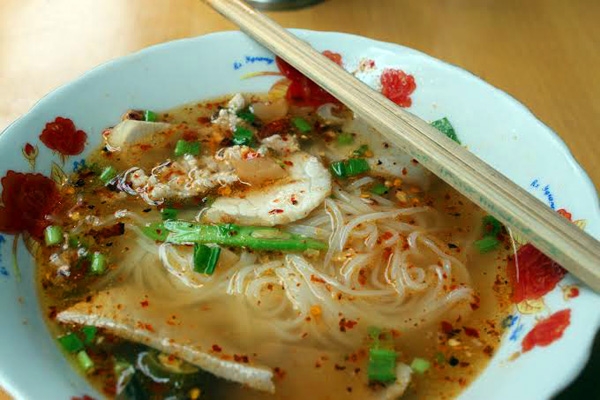THAI FOOD 101 — You wouldn’t know it, but decades ago, Sukhothai noodles were hard to find in Sukhothai.
It has only been relatively recent that this pork noodle dish – which features three ingredients which figure prominently in the region – palm sugar, limes and green beans – has practically invaded the Sukhothai food scene, showing up on nearly every local restaurant menu and street food noodle vendor’s cart.
This is purely my take on Sukhothai noodles of course, but I think of this dish as (pork) pad Thai in soup noodle form. The soup noodles are obviously taken from the Chinese. The palm sugar, lime, fish sauce, tamarind juice, chili and peanuts which season the dish are purely Thai, with an added flourish of blanched julienned green beans instead of the “usual” garnish of bean sprouts. There is also a pork bone broth in which slices of blanched pork lurk beneath the (inevitably) thin rice noodles known as sen lek, the face of the dish peppered with minced coriander leaf and a generous sprinkle of pork crackling. Like so much of Thai food, it has a foreign base that has been altered with a mixture of textures and particular balance of flavors – salt, sweet, spicy and tart – that can only be considered uniquely Thai. The closer to Sukhothai you go, the sweeter these noodles get.
It sounds delicious, doesn’t it? Strange, then, that procuring a bowl of Sukhothai noodles in the Thai capital is more difficult than you’d expect. In fact, it’s easier to find a Japanese takoyaki or ramen vendor in Bangkok than it is to find these noodles. For whatever reason, Sukhothai noodles here are overshadowed by flashier cousins like the easier-to-please bamee (egg noodles) or shamelessly piggier guay jab (Chinese hand-rolled noodles with pork innards). Hence street food aficionados craving a taste of the old OLD Thai capital are forced to ferret out Sukhothai noodle vendors like homesick TV watchers seeking DVDs of “Friday Night Lights,” were I not the only Bangkokian who seems familiar with this show.

TOP: Sukhothai noodles at Somsong Pochana. ABOVE: Khao fang dessert at Somsong Pochana.
Luckily, some vendors specialize in hard-to-find Thai dishes. One of these vendors is Somsong Pochana (Soi Wat Sangwech, or the soi next to Phra Sumen Fort off of Phra Arthit Road, 02-282-0972), which serves a toothsome Sukhothai noodle with a heady pork broth, but a more restrained hand with the sugar. Although I always order my noodles dry (hang) – the weather is far too hot to deal with a smoking hot broth – Khun Tiew the proprietor advises diners to order their noodles with broth (nam) for better flavor.
Somsong Pochana doesn’t just traffic in Sukhothai noodles; there are also underappreciated gems like kanom jeen sao nam (Mon-style fermented rice noodles topped with pineapple, shrimp, garlic, fish sauce, coconut milk and chilies) and the genuinely delicious khao fang (boiled millet with coconut milk), a sight so pretty to this particular diner that it became the wallpaper for her laptop. And if these Thai dishes don’t float your boat, there is always the khao gaeng (selection of curries over rice), which change on a day-to-day basis, to choose from. This is probably the reason why Somsong Pochana is easily one of my favorite street food places in the city.
Thai Food 101:
US-Thai relations reach a critically spicy level in our Sriracha Smackdown
Straight Outta Lanna: The khao soy connection
Just beat it: Laziness is killing our som tum flavor
If Game of Thrones was Thai street food
Satawesome or satawful: Reconsidering a troubled relationship with the stink bean
Catching the tail end of the summertime rice festival
Dr. Stinkfruit or: How to Stop Worrying and Love Durian
How to Yum: Make a tasty salad with whatever you got
Nam Prik 101: Is Thailand losing its pungent, chili paste heritage?
The Other Starch: Kanom jeen is the answer to rice burnout




